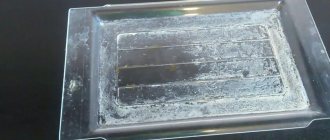For every housewife, cleanliness in the house is determined by one or more parameters. For example, the degree of cleanliness of the stove or bathroom. The bathroom is the place most susceptible to limescale. The bathtub, shower cabin and toilet are plumbing products where water is constantly present. Depending on the region, the water contains different amounts of dissolved salts, which, when released onto surfaces, pollute them. Despite the fact that the water that comes from the central water supply is purified, a certain amount of salts remains in it.
Depending on the degree of water hardness, the problem of contamination with limescale and rust arises for apartment owners once a month or several times a week.
How to clean a toilet from limescale and urinary stones
There are several ways and means to remove limescale and stone. Depending on the degree of contamination and the area of limescale deposits.
The use of special cleaning agents is justified if the resulting area of contamination is significant and the contamination itself is of an old nature.
Ordinary household products will also work as cleaning products. They will be effective if the pollution is not deep and relatively “fresh”. For these purposes, you can use citric acid, acetic acid, baking soda and soda ash. All products used can be divided into two groups containing acids or alkalis as active ingredients.
Rules for working with household chemicals
In pursuit of a clean toilet, it is important not to rush and avoid mistakes.
To do this you need to follow a few simple rules.
- To avoid causing damage to the enamel and the accumulation of new plaque, never overexpose gels and acid-based liquids.
- After cleaning, rinse off any aggressive cleaning agent with water only with the lid closed so that splashes do not get on the skin.
- To avoid chemical skin burns, vapor poisoning or an allergic reaction, try to work with household chemicals wearing protective gloves and a mask, and do not lean too much over the surface being treated.
- Never use Electrolyte or any other sulfuric acid-based liquid if metal-plastic pipes lead to the toilet.
When the cleaning is done and the toilet is sparkling clean, the question arises: how to prolong this condition and prevent the formation of new contaminants?
When choosing household chemicals to remove limescale, focus on the composition, the main active ingredient, the scale of the problem and the condition of the toilet itself. Also, when choosing, you should take into account the cost and toxicity of the gel or liquid.
Reasons for the problem
The cause of plaque and urinary stones is hard water, in which organic salt compounds and organic residues are dissolved, settling on the walls. This can be either food or urea contained in urine. In some cases, salt deposition increases if the water drain from the washing machine is directed to the toilet.
Water may also contain iron compounds, which, together with limescale, form streaks of rust. Which are more difficult to remove than just plaque. The formation of rust is also promoted by a leaking barrel, water continuously flowing along the walls, destroying the coating of the toilet, rendering it unusable.
Preventing the formation of contaminants
Once you try to remove traces of old plaque or rust using one of the above methods, you will come to the conclusion that it is better to prevent than to make such efforts.
Especially when you consider that preventive measures are quite simple and require much less time and effort.
- To prevent the formation of limescale, use special tablets for the tank. Their main action is aimed primarily at softening water and neutralizing alkalis. They also tint the water in various shades and give it a pleasant aroma;
- Gel-like products that are attached to the rim of the toilet disinfect the surface with each flush and prevent the formation of urinary stones;
- Make sure that the toilet tank does not leak, otherwise the formation of rust is inevitable;
- If the tank is functioning normally, but rust still forms, it is necessary to replace the old water pipes, otherwise the problem will not go away. If the pipes in the apartment are plastic, it means that corrosion has affected the iron pipes of the central water supply. In this case, only installing a filter will help;
- Once a week, treat the surface of the toilet with chlorine-containing products or regular white. This is both a method of disinfection and elimination of unpleasant odors, and a way to combat the appearance of limescale;
- If the design allows, once a week remove the lid and toilet seat and wash them well with any detergent and then under hot water;
- Make sure that all family members use the drain regularly, otherwise your efforts will be in vain.
Tags:Toilet
- Previous: How to choose and install a dog enclosure in an apartment
- Next: What is: Repair of a one-room apartment
Rules for cleaning the toilet
When using any cleaning product, several rules must be followed. The first rule is respiratory and skin protection. A shiny and clean toilet is unlikely to please the owner if her mucous membranes or hands are burned. After completing the work, the room must be thoroughly ventilated.
To work, you will need durable rubber gloves, a respirator, paper towels or non-woven napkins, a special syringe, a brush or sponge.
The most effective cleaning products and methods
Supermarket shelves offer a wide range of different household chemicals. These products are manufactured by professionals in an industrial manner. Each anti-plaque product must have instructions that must be read carefully so that cleaning the toilet is not only effective, but also safe.
If, in addition to the walls, you need to clean the toilet lid, then a melamine sponge is perfect for this purpose. Reviews about her are the most positive. Many housewives claim that with the help of a miracle sponge, without using chemicals, you can clean a surface like an eraser without damaging it.
How to remove deposits using improvised means?
Citric acid can be used as an effective remedy. For small limescale deposits, 100 g is sufficient. acids. It can be dissolved in a small amount of hot water and poured into the toilet.
If there are deposits in hard-to-reach places, they should be covered with paper towels or napkins soaked in a solution of citric acid. The exposure time depends on the density of the layer and ranges from 20 minutes to 1 hour.
After rinsing off the citric acid, difficult stains can be scrubbed with a brush. If necessary, the procedure can be repeated several times. Citric acid dissolves and softens the limescale layer.
Acetic acid and baking soda are also suitable as a means at hand. The disadvantage of this combination is the release of acetic acid vapors when it is heated and applied to the surface.
To create a working solution you need 200 ml. acetic acid in a 9% solution and 1 tablespoon of baking soda. Acetic acid is heated to 40 C and a spoonful of soda is added. Heating must be carried out in a closed container, since acetic acid evaporates even more intensely when heated.
The interaction of acetic acid and soda during a chemical reaction breaks down lime deposits. You can add a few drops of iodine to the prepared mixture. But if the toilet bowl coating is damaged, the surface may be stained with iodine. You can wash off the applied mixture after an hour. If time permits, it can be left for several hours.
Another type of soda can be used to clean surfaces with fairly high efficiency. Sodium carbonate is used for intensive water softening. When it is added, the effectiveness of detergents and cleaning products increases significantly. As with acetic acid, precautions must be taken; soda ash can cause irritation if it comes into contact with the skin.
As an experiment, you can use some types of drinks, for example, Coca-Cola, to clean products. Its effect on pollution is based on the acids it contains. But since the acid content is insignificant, Coca-Cola must be left for a significant period of time, up to 12 hours.
What to do if the plastic cover turns yellow?
It happens that over time the plastic on the lid turns yellow. To whiten the toilet lid from yellowness, it is best to remove it first, if the design of the toilet allows it. If this cannot be done, apply all the products described below with a sponge and leave for a while. If you still managed to remove the lid, then clean it by soaking.
What products bleach plastic lids well:
- detergents containing chlorine or chlorine bleach;
- hair lightening agent;
- a solution prepared from ordinary washing powder, soda and water;
- "White";
- “Cosmofen 10” is a product for cleaning PVC window profiles from heavy dirt.
Important! Before bleaching the lid, do a test on a small, inconspicuous area.
After the renovation I am decorating the apartment. Problem with the toilet. The toilet itself was cleaned perfectly - thanks to the Red Triangle. But the seat has a cover. I don’t know what it’s made of—plastic, melamine. But the yellowness was literally ingrained :(. I tried Asom - the small spots seemed to go away, and where there was strong yellowness it became noticeably whiter. But the most ingrained spots still remained :(.
What else should I try? Maybe Komet or Domestos or something else bleaching? Will it damage the plastic?
Throwing out the seat and buying a new one is not suggested, since I have it together with a bidet











